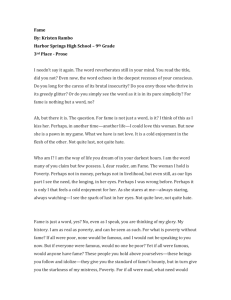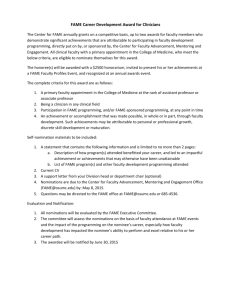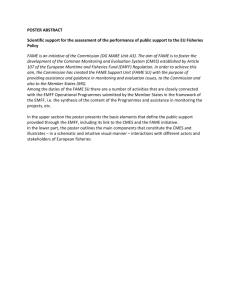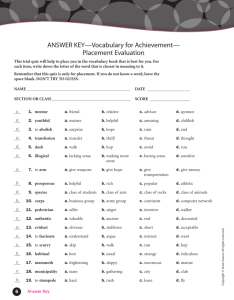Modeling Unconscious Gender Bias in Fame Judgments: Finding
advertisement
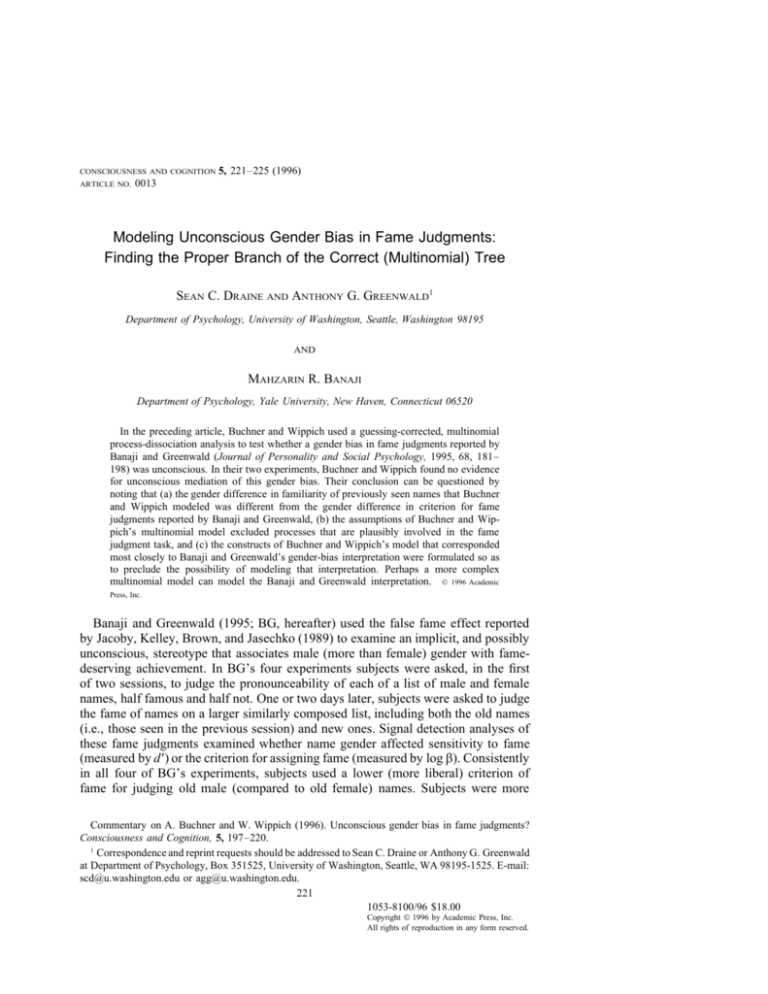
CONSCIOUSNESS AND COGNITION ARTICLE NO. 5, 221–225 (1996) 0013 Modeling Unconscious Gender Bias in Fame Judgments: Finding the Proper Branch of the Correct (Multinomial) Tree SEAN C. DRAINE AND ANTHONY G. GREENWALD1 Department of Psychology, University of Washington, Seattle, Washington 98195 AND MAHZARIN R. BANAJI Department of Psychology, Yale University, New Haven, Connecticut 06520 In the preceding article, Buchner and Wippich used a guessing-corrected, multinomial process-dissociation analysis to test whether a gender bias in fame judgments reported by Banaji and Greenwald (Journal of Personality and Social Psychology, 1995, 68, 181– 198) was unconscious. In their two experiments, Buchner and Wippich found no evidence for unconscious mediation of this gender bias. Their conclusion can be questioned by noting that (a) the gender difference in familiarity of previously seen names that Buchner and Wippich modeled was different from the gender difference in criterion for fame judgments reported by Banaji and Greenwald, (b) the assumptions of Buchner and Wippich’s multinomial model excluded processes that are plausibly involved in the fame judgment task, and (c) the constructs of Buchner and Wippich’s model that corresponded most closely to Banaji and Greenwald’s gender-bias interpretation were formulated so as to preclude the possibility of modeling that interpretation. Perhaps a more complex multinomial model can model the Banaji and Greenwald interpretation. 1996 Academic Press, Inc. Banaji and Greenwald (1995; BG, hereafter) used the false fame effect reported by Jacoby, Kelley, Brown, and Jasechko (1989) to examine an implicit, and possibly unconscious, stereotype that associates male (more than female) gender with famedeserving achievement. In BG’s four experiments subjects were asked, in the first of two sessions, to judge the pronounceability of each of a list of male and female names, half famous and half not. One or two days later, subjects were asked to judge the fame of names on a larger similarly composed list, including both the old names (i.e., those seen in the previous session) and new ones. Signal detection analyses of these fame judgments examined whether name gender affected sensitivity to fame (measured by d′) or the criterion for assigning fame (measured by log β). Consistently in all four of BG’s experiments, subjects used a lower (more liberal) criterion of fame for judging old male (compared to old female) names. Subjects were more Commentary on A. Buchner and W. Wippich (1996). Unconscious gender bias in fame judgments? Consciousness and Cognition, 5, 197–220. 1 Correspondence and reprint requests should be addressed to Sean C. Draine or Anthony G. Greenwald at Department of Psychology, Box 351525, University of Washington, Seattle, WA 98195-1525. E-mail: scd@u.washington.edu or agg@u.washington.edu. 221 1053-8100/96 $18.00 Copyright 1996 by Academic Press, Inc. All rights of reproduction in any form reserved. 222 DRAINE, GREENWALD, AND BANAJI likely to attribute their sense of familiarity with old names to fame when the name was male rather than female. Because BG’s gender difference in fame judgments occurred only when names had been given a boost in familiarity by an unremembered prior presentation, BG suggested that it reflected an unconsciously operating, or implicit, stereotype. This implicit-cognition interpretation was also supported by subjects’ postexperimental reports of unawareness of any relation between name gender and their fame judgments and by the lack of correlation of individual–subject criterion differences for male versus female familiarized names with explicit measures of gender stereotyping. The possibility of implicit operation of discriminatory stereotypes is significant because such stereotypes may be difficult to suppress, even by well-intentioned persons. (Greenwald & Banaji, 1995, reviewed previous findings that indicated pervasive implicit operation of stereotypes.) Buchner and Wippich (1996a; BW, hereafter) set out to test whether the gender stereotyping observed by BG could be considered unconscious. BW used an ‘‘extended measurement’’ multinomial process dissociation model (Buchner, Erdfelder, & Vaterodt-Plünnecke, 1995) as the methodological tool for distinguishing conscious from unconscious components of fame judgments. The relevant portion of BW’s findings and conclusions was summarized as follows: In both Experiments 1 and 2, we found that the criterion for calling a name famous was more liberal for male names than for female names. While these results . . . replicated findings reported by Banaji and Greenwald (1995), they also presented problems for assessing whether the biases in the fame judgments were due to unconscious, automatic memory processes. . . . Unfortunately, in both of our experiments a supposedly ‘unconscious’ effect on fame judgments disappeared as soon as response bias effects were taken into account explicitly by applying the extended measurement model for the process dissociation procedure. (Buchner & Wippich, 1996a.) In the following paragraphs, we comment on BW by noting that (a) the gender difference that they observed was not the same one that was critical to BG’s conclusion about unconscious or implicit operation of a gender stereotype, (b) BW’s extended measurement model omits representation of some processes that were likely involved in fame judgments, and (c) the portion of BW’s extended measurement model that corresponds to BG’s critical gender-bias finding is formulated so as to define that gender-bias effect out of existence. Individually, and certainly also in combination, these three points imply that BW’s methods and findings are focused on issues other than interpreting the gender bias observed by BG. What gender difference did BW observe? In Session 1 of BW’s procedure, subjects studied a list of 10 famous and 60 nonfamous male and female names. In Session 2, a day later, the same subjects classified, as famous or not, names on a longer list that included Session 1’s 60 nonfamous names along with 60 new nonfamous and 60 new famous names. For BW’s inclusion condition subjects were (mis)informed that, if they could recall the name as one that had been presented in Session 1, they could be sure that it was famous. For their exclusion condition, subjects were instead informed that if they could recall the name as one presented in Session 1, they could be sure that it was not famous. BW modeled the probability of classifying names as COMMENTARY 223 ‘‘famous’’ under these inclusion and exclusion instructions using a multinomial binary tree model of the process of making the judgments in each condition (see Fig. 1 of BW). According to their model, subjects’ judgments of fame are determined by three cognitive processes that they identified as conscious influences of memory, unconscious influences of memory, and guessing. BW identified unconscious influences of memory on fame judgments with a model parameter (u c2 ) that increases to the extent that exclusion-condition subjects, contrary to their instructions, classify as ‘‘famous’’ names that had been presented in the first session. By contrast, the conscious contribution to fame judgments is estimated by a model parameter (c) that increases to the extent that, consistent with instructions, inclusion-condition subjects classify as ‘‘famous’’ names that had been presented in the first session or exclusion-condition subjects classify those same names as ‘‘nonfamous.’’ In both of their experiments, BW observed a gender difference: The probability of classifying as ‘‘famous’’ all names (and especially famous names) was greater for male than female names (see their Tables 1 and 2). In judging whether greater judgments of fame for male names could be given an interpretation as reflecting unconscious process, BW concluded no, because their multinomial model’s uc2 parameter was similar in value for male and female names. As they expressed it, ‘‘if the gender bias was unconscious effect, then we would expect uc2 to be larger for male than for female names’’ (p. 20 of draft). From BW’s discussion and their multinomial model, it can be seen that their u c2 parameter represents the unlabeled sense of familiarity that can occur when, in Session 2, a previously presented nonfamous name is not recalled as having been seen in Session 1. Rather than being contrary to BG’s analysis, however, such equal familiarity for previously presented nonfamous male and female names was assumed by BG. BG assumed that the male–female difference, rather than being in experienced familiarity of previously presented male and female names, was in the level of familiarity (criterion) required for judging that these names were famous. Consequently, BW’s finding of no difference in the familiarity (u c2) parameter between male and female names was fully consistent (and not, as BW suggested, at odds) with the BG interpretation. What happens when male and female nonfamous names seem familiar? As already described, BW interpreted their u c2 parameter as the probability of being in the state of familiarity when presented with an old nonfamous name that was not recalled as having been seen in their prior session. It can be seen in BW’s Fig. 1 that this state is assumed always to produce a judgment that the name is ‘‘famous.’’ However, selfreports of subjects who have been in false fame experiments indicate that this state can also lead to judgments of ‘‘nonfamous,’’ either (a) when subjects attribute the familiarity to extraexperimental sources (for example, they might have nonfamous acquaintances with the same first or last names or they might judge that the names seem rather common) or (b) when subjects attribute the familiarity (correctly) to forgotten Session-1 exposure.2 Therefore, BW’s model appears to be limited in its 2 Occurrences of condition (a) of this sentence would produce violations of BW’s assumptions for both inclusion and exclusion conditions, and occurrences of condition (b) would produce violations of their assumptions for the exclusion condition. 224 DRAINE, GREENWALD, AND BANAJI ability to model false fame experiments because, counter to a reasonable interpretation of the fame judgment task, it includes no representation of paths that can lead from familiarity-without-recall to any judgment other than ‘‘famous.’’ How might the multinomial model demonstrate a criterion difference in assigning fame to familiarized male and female names? As explained in the preceding two paragraphs, BG supposed that familiarized nonfamous male and female names should have equal familiarity when presented in Session 2. What BG presumed to differ between male and female names was their likelihood of being judged famous once that state was achieved. In BW’s model, familiarity-without-recall always leads to judgment of ‘‘famous’’ for old nonfamous names and therefore does not map onto the idea of a variable criterion for assigning fame to unrecalled-but-familiar-seeming male and female names. At the same time, the multinomial model’s guessing parameters (g i for guessing in the inclusion condition and ge for the exclusion condition) may provide analogs to signal detection theory’s concept of a variable response criterion. The critical BG finding (their gender difference in criterion for familiarized male and female names) might be modeled as a gender difference in g for old but not new nonfamous names. Unfortunately, the structure of BW’s multinomial model is such that g (for either inclusion or exclusion) is obliged to have the same value for old and new nonfamous names. Consequently, the intrinsic structure of the BW binary tree model precludes its providing a model of the critical BG finding. Conclusion. The three points made in this comment indicate that Buchner and Wippich’s (1996) methods and findings were focused on issues other than interpreting the possibly unconscious nature of the gender bias in fame judgments observed by Banaji and Greenwald (1995). We do not consider that Banaji and Greenwald provided ultimately conclusive evidence on the conscious versus unconscious nature of the gender stereotyping that they observed. Conceivably, more complex extensions of the measurement model developed by Buchner et al. (1995) will yet shed light on this interesting issue. Postscript. In their following rejoinder, Buchner and Wippich suggest that subjects’ opportunity to attribute Session-2 name familiarity to extraexperimental exposures can be safely ignored in the multinomial model of a false fame experiment (Buchner & Wippich, 1996b). However, in the typical word-list experiment for which the Buchner et al. (1995) model was developed, subjects know that they can attribute Session-2 familiarity of words only to (1) extraexperimental exposures and/or (2) Session-1 exposure. In false fame experiments there is a third attribution opportunity—to (3) actual fame. BW modeled only attributions (2) and (3). However, even the relatively uncommon first and last names that they used must have had many unpaired extraexperimental exposures, much like low or moderate frequency words in the language. The multinomial model of a false fame experiment might therefore need to accommodate three types of attributions for Session-2 name familiarity, rather than only two. ACKNOWLEDGMENTS Preparation of this report was facilitated by National Institute of Mental Health Grant MH41328 and National Science Foundation Grant SBR-9422242. COMMENTARY 225 REFERENCES Banaji, M. R., & Greenwald, A. G. (1995). Implicit gender stereotyping in judgments of fame. Journal of Personality and Social Psychology, 68, 181–198. Buchner, A., Erdfelder, E., & Vaterrodt-Plünnecke, B. (1995). Toward unbiased measurement of conscious and unconscious memory processes within the process dissociation framework. Journal of Experimental Psychology: General, 124, 137–160. Buchner, A., & Wippich, W. (1996a). Unconscious gender bias in fame judgments? Consciousness and Cognition, 5, 197–220. Buchner, A., & Wippich, W. (1996b). Investigating fame judgments: On the generality of hypotheses, conclusions, and measurement models. Consciousness and Cognition, 5, 226–231. Greenwald, A. G., & Banaji, M. R. (1995). Implicit social cognition: Attitudes, self-esteem, and stereotypes. Psychological Review, 102, 4–27. Jacoby, L. L., Kelley, C., Brown, J., & Jasechko, J. (1989). Becoming famous overnight: Limits on the ability to avoid unconscious influences of the past. Journal of Personality and Social Psychology, 56, 326–338.

